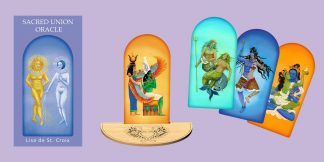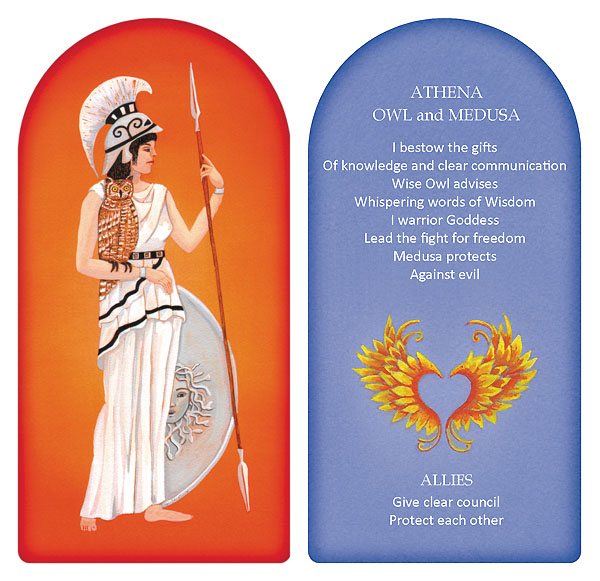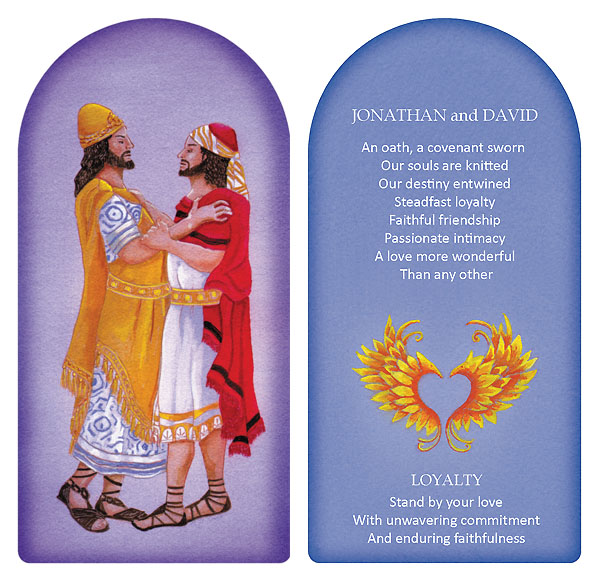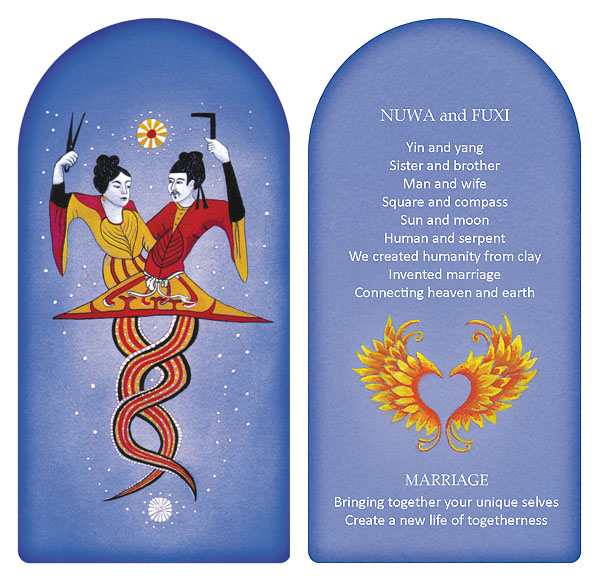“As we move from a focus on interiority, back to the value of interconnectedness Lisa de St. Croix brings our awareness to the sacredness of relationship. Her images are a prism of the holy in cultures around the world, expressing the common heart thread while highlighting and honoring their unique offerings. Each image bears its own magical love gift for our meditation.” Marina Aguilar
“Sacred Union Oracle is an altar in a box. These paintings are luminous and full of life and will leave you awestruck and breathless. The arched cards are gateways marking the thresholds between the profane and the divine; a holy temple unto itself, Sacred Union Oracle can be used as daily devotionals. Inspiring personal spirituality, this will be one of your most prized decks. Her paintings inspire and uplift your mind into the realm of the spiritual.” Benebell Wen
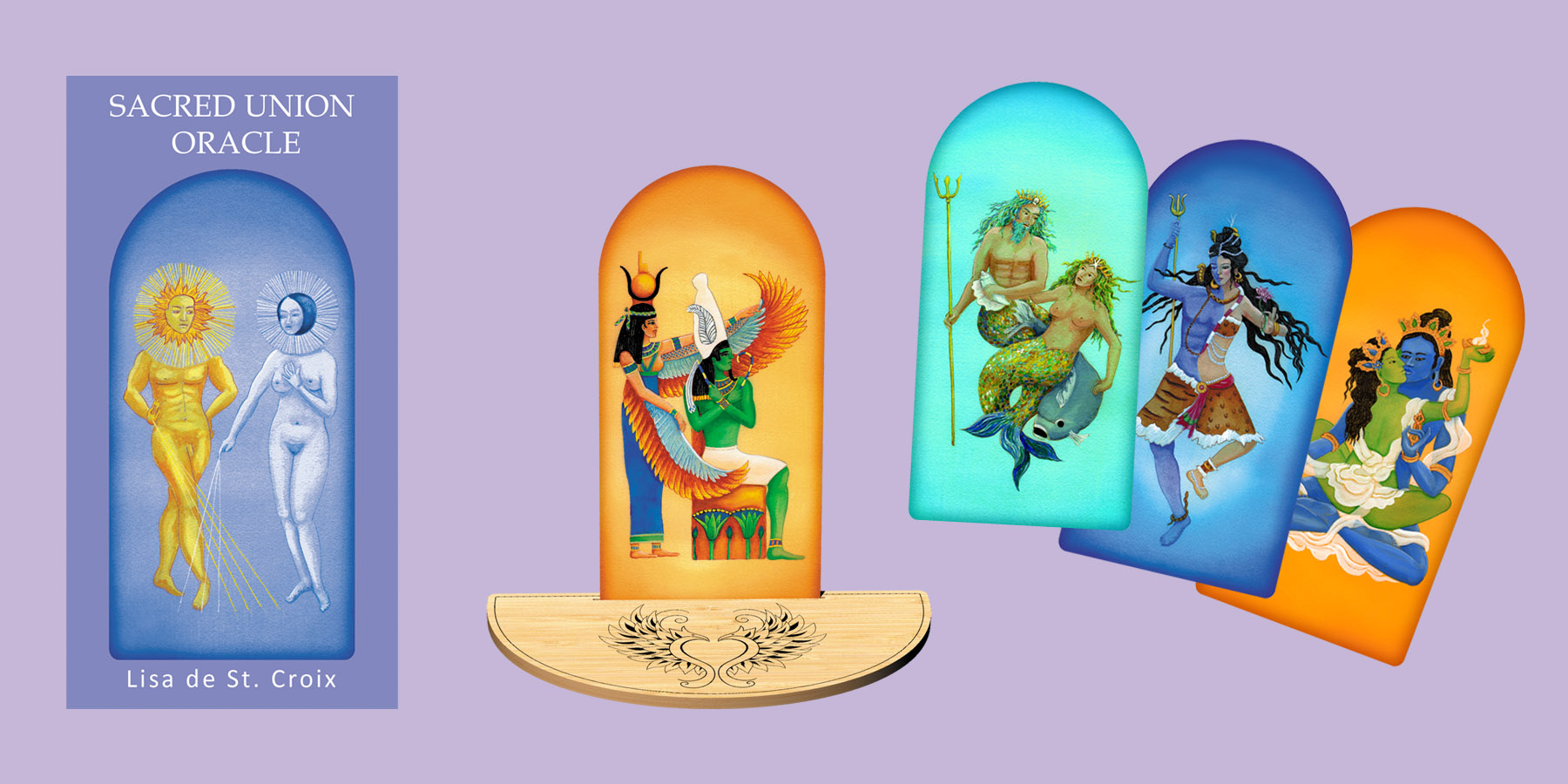
Sacred Union Oracle is a deck that explores relationships and what it means to be in sacred union. Deities and historical figures from many cultures are archetypes and guides. Each card gives an oracle that tells their story and an action to enhance your life and your relationships.
The cards are 6″ x 3″ and are shaped like altar cards with an arch top. The bamboo card holder is an invitation to place your card on an altar, in a shrine or simply in view. Printed on heavy card stock, the cards have the image on one side and the oracle and action on the back.
Browse the Deck
ATHENA, the OWL and MEDUSA
Athena is the Greek Goddess of wisdom and philosophy, warfare, and a patron of arts and crafts.
Athena’s father Zeus married Metis, Athena’s mother’ who is described as the wisest among gods and mortals. When Zeus found out that Metis was pregnant, he was afraid because it had been prophesied that Metis would bear children wiser than their father, so he swallowed Metis. Athena was born from the forehead of Zeus. Athena is a maiden Goddess, a virgin.
Athena is often depicted with an owl on her arm. The owl brings knowledge and whispers wisdom in Athena’s ears. Athena bestows “the owl gift” on her worshippers, giving them the ability to write and communicate clearly. In some accounts Athena was an early Bird Goddess. Occasionally she is portrayed with wings and an owl mask.
Athens is named after her and the Parthenon on the Acropolis of Athens is dedicated to her, built in 440 BC. The owl was the mascot of the Athenians who worshipped Athena and coins were made with Athena on one side and the owl on the other.
Beautiful Medusa was a high priestess in the temple of Athena. Poseidon lusted after her and raped her in the temple, breaking her vow of chastity. Athena was so enraged at the defilement of her temple that she turned Medusa into a Gorgon with snakes for hair and a gaze that could turn man to stone. Athena wears Medusa on her shield to ward off evil.
BARON SAMEDI and MAMAN BRIGITTE
Baron Samedi and Maman Brigitte are the Haitian Vodou death Loas (spirits). They can be found at the crossroads between the living and the dead. They either escort mortals through the portal of death or can be called upon to cure those who are near death. They are amongst the most respected and powerful of the Loas in Vodou. They are lewd, crude and charming. They like to drink rum, smoke cigars and are accompanied by a black rooster.
Baron Samedi and Maman Brigitte are the head of the Ghede family, the Loas of life and death, and heritage. Maman Brigitte is tied to the Celtic Goddess Brigid and was included into Vodou by incarcerated Irish women sent to work on the plantations. She is the guardian of cemeteries.
Baron Samedi and Maman Brigitte teach us to enjoy life while we are living and to not fear death. Their irreverence lightens the passage between the worlds.
BLACK MADONNA and CHILD
DANU and CERNUNNOS
Danu is the source Celtic Goddess, namesake of the Tuatha de Danaan. Danu gives ancestral power and wisdom to her offspring. The Danube river is named after her.
Cernunnos is the Celtic God of nature, surrounded by animals, who rules the wilderness. He brings natural enemies together in peace. He was a precursor to the God Pan and the Green Man.
DEMETER and PERSEPHONE
Demeter is the Greek Goddess of grain, agriculture and harvest. Her daughter Persephone, also known as Kore which means maiden, had the responsibility of painting all the flowers on earth. Hades falls in love with Persephone and abducts her to be his Queen of the Underworld. Bereft, Demeter withdraws from the earth to search for Persephone, causing the land to become barren. Zeus, afraid that all living things will die, orders Hades to return Persephone. He agrees only if she has not eaten anything, but Persephone has consumed a small amount of pomegranate seeds so she is only able to return to her mother for part of the year– the growing seasons. Demeter is overjoyed to be reunited with her daughter and the land once again becomes fertile and abundant.
Demeter and Persephone were the central Goddesses of the Eleusian Mysteries which dates back to 1400 BC. The main theme of the huge festival was the reunion of the two. The ceremonies included secret initiations and rites, possibly involving hallucinogenics derived from poppies.
EROS and PSYCHE
Eros is the son of the Goddess Aphrodite. Eros is also known as Cupid. Eros personifies love, desire and sexuality. He throws arrows into the hearts of people which makes them fall in love. Psyche is the beautiful daughter of a mortal King and Queen. Psyche means soul in Greek. Her aspiration is to find divine love and her soul mate.
The earliest depictions of Eros and Psyche were found in Greek art dating from 4th century BC. However the most known account of Eros and Psyche is from Metamorphoses, written by Apuleius in the 2nd century AD.
The story tells of Eros and Psyche overcoming many obstacles to their love and their ultimate union in sacred marriage. Aphrodite is jealous of Psyche’s beauty which rivals hers, so she sends her son Eros to shoot Psyche with an arrow to make her fall in love with something hideous. Eros accidentally scratches himself with his arrow, which makes him fall in love with Psyche and he disobeys his mother’s order. Psyche is tricked into a sexual relationship with Eros without ever seeing him, as he arrives and leaves under the cover of darkness. Psyche’s sisters encourage her to look at him while he sleeps; he is the most beautiful man she has ever seen. In her passion she wounds herself on one of his arrows and accidentally spills some wax onto him. He wakes up and flies away. Psyche wanders the earth looking for Eros. Eventually she ends up in Aphrodite’s temple and is given several impossible tasks. Eros helps Psyche, lifting her into the air so she can fulfill her tasks. Eros then makes a bargain with Zeus who tells Aphrodite to back off. Psyche is given ambrosia, the drink of immortality and the couple are married as equals and live in bliss.
FRIGG and ODIN
Frigg is the Norse Goddess of marriage, prophesy and motherhood. Frigg is the Queen of Asgard and is the highest ranking of the Aesir Goddesses, married to Odin who is the leader of Gods. She is the mother of Baldur. Her name means to love or beloved and Friday is named after her. She is a völva – a practitioner of Norse magic known as seidr. Seidr is the ability to foretell the future and to alter the course of fate.
Odin is a prominent God in Germanic and Norse mythology. He is the God of royalty, wisdom, healing and victory in war. Odin is attributed to being the inventor of poetry and the runic alphabet. He is often accompanied by his animal familiars – wolves and ravens.
Even though Odin is the God of Knowledge, Frigg often wagers and wins bets with him. Odin asks his intelligent wife for advice on many issues, because being clairvoyant Frigg knows about the future.
HANUMAN, RAMA and SITA
ISHTAR and TAMMUZ
The myth of Ishtar and Tammuz is the oldest recorded love story. Ishtar and Tammuz had a powerful sexual attraction and were tireless lovers. The fertility of the earth was the result of their copulation.
Ishtar, also known as Inanna, was the Mesopotamian Goddess of love, desire, sex and war. She is the first deity that was recorded in writing by Enheduanna in 2285 BC. Enheduanna was a priestess of Ishtar and is the first known author. Ishtar/Inanna was widely worshipped for thousands of years throughout the Fertile Crescent between the Tigris and Euphrates Rivers as far back as the 4th millennium BCE. Mesopotamia which now covers Iran, Iraq, Syria and Turkey was home to the great Akkadian, Babylonian and Assyrian Empires. Ishtar was later associated with Astarte, Aphrodite and Venus. Ishtar was known as the Queen of Heaven, daughter of the sky – Anu and daughter of the moon – Nannar. Ishtar’s symbol – the eight pointed star was used as a seal for thousands of years. Ishtar’s sexuality is a vital aspect of her image.
Tammuz, also known as Damuzi, is an agricultural deity, a shepherd. He dies and is reborn annually; the cult of Tammuz even appears in the Bible where Ezekiel witnesses the weeping of women for the slain God. The Babylonian myth of Tammuz as the dying and resurrected God bears similarities to Osiris and Jesus. Tammuz dies with the dying vegetation and resurfaces with the new crop of grain. Tammuz is also a guardian and a healer.
The ancient Sumerian love poem between Inanna and Dumuzi refers to their joyous sacred marriage rites:
My Vulva, the horn, Boat of Heaven,
is full of eagerness like the young moon
As for me, Inanna, who will plow my vulva?
Who will plow my high field?
Who will plow my wet ground?
As for me, the young woman, who will plow my vulva?
Great Lady, the king will plow your vulva.
I, Dumuzi, the king will plow your vulva!
Then plow my vulva, man of my heart!
Plow my vulva!
At the kings lap stood the rising cedar.
Plants grew high by their side.
Grains grew high by their side
Gardens flourished luxuriantly.
Inanna sang:
He has sprouted; he has burgeoned;
He is the one my womb loves best
Afterwards, pleased by her lover Tammuz, Ishtar decrees lifelong sovereignty for him and fertility and prosperity for the land.
ISIS and OSIRIS
Isis and Osiris are the most powerful deities of the Egyptian pantheon. They are the children of the sky – Nut and the Earth – Geb. Their worship dates back to the 25th century BC. Isis and Osiris were considered the divine parents of Pharaohs.
Isis is the feminine aspect of divinity worshipped throughout the Middle East and Europe. Isis is the ruler of fate and destiny. She is compassionate and relieves human suffering.
Osiris is the God of fertility, vegetation, agriculture. His green skin symbolizes rebirth. He is often depicted as a partially wrapped mummy as he is the God of both life and death.
Isis resurrects her slain husband Osiris, through healing spells and magic. She conceives and gives birth to Horus.
IZANAGI and IZANAMI
JONATHAN and DAVID
Jonathan and David are heroic figures from the Hebrew Bible. Jonathan was the son of Saul – the King of Israel and David was the son of Jesse from the tribe of Judah. At first they were rivals for the crown. Jonathan opposed his father Saul’s wish to kill David, talking him out of it. Jonathan and David formed a deep and abiding friendship and made an oath to each other. Eventually David became King, and after Jonathan’s death David brings Jonathan’s son Mephibosheth to his royal table instead of eradicating King Saul’s line.
Several biblical passages talk of the passionate and faithful love between Jonathan and David.
The soul of Jonathan was knit to the soul of David, and Jonathan loved him as himself
Jonathan made a covenant with David, because he loved him as his own soul
(1 Samuel 18:3)
Jonathan; You have been very pleasant to me. Your love to me was more wonderful than the love of women
In modern times some scholars have concluded that their love was homosexual. There are a number of gay Roman Catholic groups using the names of David and Jonathan: Davide e Gionata (Italy) and David et Jonathan (France).
JOSEPH and JACOB
KING ARTHUR, GUINEVERE and LANCELOT
The Arthurian legend was written in the 12th Century, 700 years after the times of King Arthur in Celtic Britain. Queen Guinevere was Arthur’s wife who was involved in a tragic love affair with her husband’s chief knight and dearest friend Lancelot. One of the most famous love triangles involves the three of them.
There are many versions of the story in both prose and poetry. In the Lancelot-Grail prose cycle Lancelot arrives from Europe and is knighted by Guinevere as the White Knight and dedicates all his heroic deeds to her honor. Arthur and Guinevere were happily married and in love, but slowly over time Lancelot and Guinevere also fall in love. After saving Guinevere from Maleagant who had abducted her, they began an adulterous relationship. They tried to keep their affair secret but it became known and caused a civil war which led to the fall of the Round Table and Camelot and led inadvertently to Arthur’s death. Guinevere was heartbroken and spent the remainder of her life in a convent, Lancelot was unable to convince her to come away with him. After her death Lancelot buries her next to Arthur.
KING SOLOMON and QUEEN SHEBA
MAGDALENE and YESHUA
Mary Magdalene travelled with Jesus/Yeshua as one of his followers. She was a witness to Jesus’ crucifixion and resurrection. She helped support his ministry, indicating that she probably was a wealthy woman. Magdalene was the one who really understood Yeshua’s teachings. Mary Magdalene is mentioned twelve times in the canonical gospels, and is a central figure in Gnostic writings. In the Gospel of Philip, Mary Magdalene is described as Jesus’ companion, the disciple Jesus loved the most, and the one Jesus kissed on the mouth. The Cathars believed that Mary Magdalene was Jesus’ wife.
Some believe that after the crucifixion Magdalene traveled on a boat with their child Sarah and two other Marys to the South of France where they landed. The town, named after them – Saintes-Maries-de-la-Mer, is the capital of the Camargue. The Cult of Sarah attracts hundreds of thousands of pilgrims to the town. Sarah means princess in Hebrew and some believe she was the blood line of Jesus that still exists in France and Europe. In another version it is believed Magdalene lived out her last days as a hermit in a cave in Provence and that her relics remain in Saint-Maxim-la Sainte-Baume. Magdalene is considered a saint in the Catholic, Eastern Orthodox, Anglican and Lutheran churches. In 2016 Pope Francis declared July 22nd as her Feast day and for her to be referred to as the “Apostle of the apostles”.
MARS, VENUS and CUPID
Mars is the Roman God of war, and a guardian of agriculture. Mars is virile, representing his ability to create the right conditions for crops to grow by securing peace through his military power. March is named after Mars when most of his festivals occur.
Venus is the Roman Goddess of love, sexuality, beauty, desire, prosperity, fertility and victory.
The affair of Mars and Venus is the unification of opposites – love and war. Venus is associated with water, born from sea foam, which tempers Mars’ fiery energy. Venus is able to disarm and relax Mars.
Cupid, which means passionate desire, is the son of Mars and Venus. He is the God of erotic love, desire, attraction and affection.
MAYA HERO TWINS
The Maya Hero Twins Hunahpu and Xbalanque are the central figures in the sacred text – Popol Vuh of the Quiché Maya of Guatamala. Although the Popul Vuh dates to the Early Colonial period around 1555, the Hero Twins have been identified on painted vessels and cave walls dating as far back as 1000BC. The names of the Hero Twins are in the Maya calendar as day signs.
The Twins are portrayed as complimentary, representing day and night, sun and moon, life and death, sky and earth. Hunahpu is depicted as masculine with black spots on his cheek, shoulder and arms. The sun and pronghorn antlers are his main symbols. Xbalanque, the younger twin, has patches of jaguar skin on his face and body. Smaller than his twin, he often has a feminine guise, with moon and rabbit symbols.
In the myth, their father and uncle were summoned to Xibalba by the Lords of the Underworld, where they were sacrificed. Their mother was the daughter of the God of the Underworld known as Blood Moon. The twins were conceived by the seed of their dead father. The mother fled Xibalba, and the sons grew up to avenge their father. After many trials such as the destruction of a bird demon, and turning their half brothers into howler monkey gods, they finally defeated the Lords of the Underworld in a ballgame. The Twins eventually were transformed into the sun and moon, beginning a new age.
NEPTUNE and SALACIA
Neptune is the Roman God of freshwater and the sea. His Greek counterpart is Poseidon. Neptune’s wife Salacia is the Goddess of the deep sea. Her name means wide open seas; sal, means salt.
Neptune wanted to marry Salacia but she was in awe of his powers and hid in the Atlantic Ocean. Neptune sent a dolphin to find her and bring her back. Salacia agreed to marry Neptune and together they ruled the seas. The dolphin was awarded a place in the heavens as the constellation Delphinus.
NUWA and FUXI
Nuwa is the mother Goddess of Chinese mythology. Nuwa created humanity from yellow mud fashioning the upper-class with her hands and the lower-class with a string dragged across mud. During a great battle between deities the pillars supporting heaven were broken and Nuwa patched the holes in heaven with five colored stones and used the legs of a tortoise to mend the pillars.
Fuxi is also credited with creating humanity, inventing the I Ching and Chinese calligraphy around 2000 BC, as well as music, hunting, fishing, and cooking.
Nuwa and Fuxi have human faces and the bodies of snakes. They represent Yin and Yang. Nuwa is yin/feminine and Fuxi is yang/masculine. Fuxi holds a carpenter’s square which associates him with the physical world and a straightforward mindset. Nuwa holds a compass which symbolizes the cosmos; the circles and curves indicate a more abstract mindset. Their marriage is the union of heaven and earth. The sun and moon and constellations surround them.
Although they were sister and brother, they wished to marry and made this prayer: “Oh Heaven, if Thou wouldst send us two forth as man and wife, then make all the misty vapor gather. If not, then make all the misty vapor disperse.” The mist gathered and they married. They made grass fans to screen their faces. Still to this day grass screens are used in marriage ceremonies.
OSHUN and SHANGO
Oshun is one of the most popular Yoruba Orishas/spirits from West Africa. She is a river and waterfall Goddess of beauty, love, fertility, wealth and prosperity. Oshun represents destiny and divination and is the Orisha responsible for relationships and marriage.
Shango is the Yoruba sky God of thunder and drumming. He is a powerful ruler who wields his double axe to protect his realm. Shango is called upon for coronation ceremonies in Nigeria. They are both worshipped in Afro-Brazilian religions.
Oshun and Shango fell in love at a drumming festival and Oshun became Shango’s wife. Their personalities are very different – Oshun being very soft and feminine, a water Goddess, whereas Shango is fire, the God of lightning and thunder, powerful and passionate.
RADHA KRISHNA
Radha-Krishna are the feminine and masculine form of God in Hinduism. Krishna split into two, for the attainment of bliss.
Radha, the Supreme Goddess embodies pure love, devotion and spiritual bliss. Her merciful nature is a path to the divine. Radha’s longing and love for Krishna is a symbol for the human quest for spiritual growth and union with God.
Krishna, a major Deity in India, is the God of love, tenderness, compassion and protection. Krishna is potent pleasure and is only satiated by devotion. Radha-Krishna has been worshipped in India from the first millennium BC, and since the 1960’s, Krishna Consciousness has spread to the Western World and Africa.
RUMI and SHAMS
Rumi was born in 1207, as Jalal ad-kin Muhammad Balkhi, in the Persian Empire. He lived most of his life in Konya, Turkey. His father was a Muslim scholar and mystic and Rumi followed in his footsteps as a Sufi mystic teaching in a community of dervishes.
In 1244 Rumi met Shams of Tabriz – a wandering dervish. Tabriz is in modern day Iran. As Shams wandered, he asked Allah to bring him a companion and a vision guided him to Konya and Rumi. They spent 40 days in seclusion in a state of Sobhet – ecstatic mystical communion, conversing and gazing at each other. Rumi’s students were jealous and Shams was possibly murdered by them. After Shams disappeared Rumi poured his soul into his poetry and whirling dance.
We came whirling out of nothingness,
Scattering stars like dust
The stars made a circle
And in the middle we dance
Rumi
Why should I seek
I am the same as He
His essence speaks through me
I have been looking for myself
Shams of Tabriz
Love’s greatest gift is its ability to
Make everything it touches sacred
Rumi
SAPPHO and ERINNA
Sappho is a highly regarded ancient Greek poet, who was born on the island of Lesbos around 630 BC. Sappho became celebrated for her lyrical poetry sung with the accompaniment of the lyre. Her love poetry written in the first female voice is spontaneous and emotional. Her best known work is Ode to Aphrodite. Sappho has influenced many poets across the ages, from Erinna, a contemporary of hers and possibly a lover, to the medieval lyric poets who used her Sapphic stanza, to Alfred Lord Tennyson, to modern day lesbian poets who see her as a patron saint, as her poetry reflects eros between women.
Erinna is best known for her long poem The Distaff, a 300 line hexameter, a literary version of a lament chanted by the female relatives of the deceased.
Stand and face me, my love, and scatter the grace in your eyes
Whatever one loves most, is beautiful
Now, she stands out amongst Lydian women as after sunset the rose-fingered moon exceeds all stars
Sappho
SHIVA SHAKTI
In Hinduism, the cosmic dynamic of masculine/feminine interdependence and equivalence is expressed in the half-Shakti, half-Shiva known as Ardhanari. Shiva Shakti is the sacred union of the divine masculine and feminine consciousness that is within all of us and throughout the cosmos. It is the dance of the male and female aspects that dwell inside all. When these energies unite there is complete balance.
Shiva is one of the principle deities of Hinduism. He is the patron God of yoga and meditation. Shiva is both the creator and destroyer. Shiva holds space for Shakti to move through as prana – life force and kundalini energy which rises through the spine and all chakras. They are equal and opposite forces that create a whole.
The worship of Shakti – Shaktism, focuses on the Divine Female/Devi manifested as several Goddesses. Shakti is sensual, raw and expressive, open to all possibility. Devi is the cosmos, the source for everything in creation, the embodiment of energy, matter and soul. The Devi-Bhagavata Purana states: I am Manifest Divinity, Unmanifest Divinity, and Transcendent Divinity. I am Brahma, Vishnu and Shiva, as well as Saraswati, Lakshmi and Parvati. I am the Sun and I am the Stars, and I am also the Moon. I am all animals and birds, and I am the outcast as well, and the thief. I am the low person of dreadful deeds, and the great person of excellent deeds. I am Female; I am Male in the form of Shiva.
Advaita is the understanding that everything is interconnected, all part of one consciousness. There is no duality between a Creator and the created universe. All matter, experiences, awareness is part of one fundamental reality. Shiva/Shakti is an example of this non-duality.
SUN and MOON
The Sun and Moon are also called Sol and Luna. The Moon orbits Earth as Earth orbits the Sun. The Sun, Moon and Earth are held together by gravity. The Sun illuminates the Moon as it revolves around Earth. Earth casts a shadow on the Moon, causing the various phases of the Moon. The Sun is about 400 times larger than the Moon, and is also 400 times further away from the Moon. The Moon phases control the tides of the oceans and seas and our moods and emotions. The Lunar cycle is 29.5 days and it is linked to women’s menstrual cycles. The Sun is responsible for life on Earth by warming the planet and causing the seasons of growth and rest, and it affects our energy and sleep cycle.
Many rituals around the world are based on the phases of the Moon and the Sun’s position as Solstices and Equinoxes and Cross-quarter days. The Sun and Moon represents birth and rebirth because of the seasons and phases. The Sun and Moon mean many things to different cultures and have a place in many religions and myths. There are hundreds of Sun and Moon deities around the world. Sun Gods include: Ra – Egyptian, Lugh – Celtic, Surya – Hindu, Inti – Incan, Mithra – Persian. Some Moon Goddesses are: Selene – Greek, Luna – Roman, Mawu – African, Chang’e – Chinese, Hina – Polynesian, Coyolxauhqui – Aztec, Hanwi – Lakota.
In many cultures the Sun symbolizes the masculine, and the Moon represents the feminine. They are often depicted in relationship to each other, symbolizing the union of opposites despite differences and polarity. The Sun symbolizes power, energy, rationality and strength whereas the Moon symbolizes dreams, flow, cycles, intuition and beauty.
Image inspired by a lithograph “Atalanta fugiens” by Michael Maier 1618
THOTH and SESHAT
Thoth and Seshat, are father/daughter companions from the Egyptian pantheon.
Thoth is the Ibis-headed God of reckoning, wisdom and learning. God of the moon, Thoth is a magician, giver of divine words and spells. It was Thoth who gave Isis the words that resurrected Osiris. Thoth bestows knowledge, law, science, philosophy and writing to humans.
Seshat, Thoth’s female counterpart, is a scribe, keeper of books and libraries. She is the Goddess of architecture, astronomy, mathematics and surveying. Seshat’s symbol is the seven-pointed emblem above her head. She wears a leopard hide and carries a notched stem that marks the passage of time.
VIRACOCHA and MAMA COCHA
Viracocha is the great creator God of the pre-Inca and Incan people of Peru and the Andes region of South America. Viracocha formed the earth, heavens, sun and moon. He created humanity and all animals. Viracocha taught mankind the art of civilization. Viracocha is depicted wearing the sun for a crown, with thunderbolts in his hands and tears falling as rain. Viracocha literally means sea foam, and he is intimately associated with the sea.
Mama Cocha is the Goddess of the sea, and all bodies of water. Mama Cocha provides water and brings strength. Mama Cocha has a rainbow headdress and holds a river of water between her hands. She is the wife of Viracocha.
Viracocha and Mama Cocha are the father and mother of all Incan Gods.
WE’WHA
YAB YUM
In the original paintings of Sacred Union, I used a layered wash technique to create vivid, saturated watercolor paintings. I learnt this technique while studying Sacred Painting at the Harish Johari house in Haridwar, India.
The original paintings are available for sale. They are 14″ x 10″, a rectangle on heavy watercolor paper. $660 with free shipping in USA.
Prints are available for any of the cards 12″ x 6″ with an arched top for $88. Two week delivery for US orders with free shipping. International orders should be delivered in three weeks and a shipping surcharge will be added.
To order prints or inquire about purchasing an original, use the contact form below:

